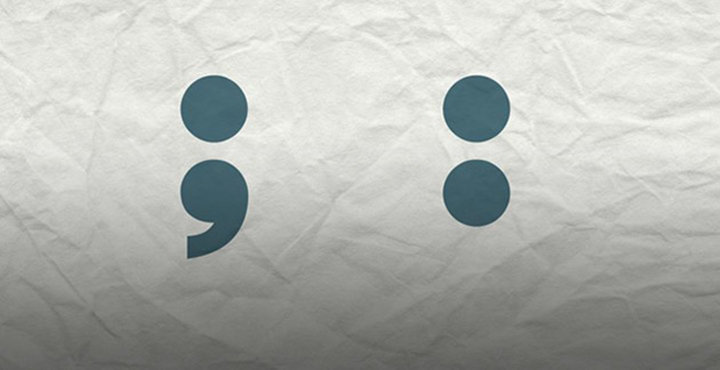How Do I Know if I Should Use Single or Double Quotes?
Should I Use Single or Double Apostrophes for Quotes within Quotes?
Do I Use Single or Double Speech Marks for Block Quotations?
I'm Writing in a Specialized Field; Should I Use Quotation Marks for Specialized Terms?
When to Use Colons and Semicolons
An Introduction to Usage
Quote marks can be confusing, especially for those unfamiliar with their English grammar and punctuation rules.
However, there's no need to be embarrassed—these upside-down commas sometimes confuse even the most seasoned writers!
How Do I Know If I Should Use Single or Double Quotes?
The short answer is that it depends on the country that you are writing in.
In British and Australian English, one typically uses single quotes. If you're writing in North America, double quote marks are typically used.
However, sometimes a publisher's or an author's style may take precedence over such general preferences.
In Butcher's Copy-editing, Judith Butcher points out that some writers have their own systems of speech marks, e.g., double apostrophe marks for speech and single quote signs for thoughts.
The most important rule when using these little punctuation marks is that the style of the opening and closing speech marks match.
Examples:
- 'Good morning, Mary,' called Adrian.
- "Good morning, Stephen," called Jane.
Should I Use Single or Double Apostrophes for Quotes within Quotes?
First things first: Decide whether you will use double or single apostrophes for the initial quote.
If you use single quote marks, you should use double speech marks for a quote within a quote. If you use double quote signs, you should use single quotation signs for a quote within a quote.
Examples:
- "When I say 'immediately,' I mean sometime before August," said the manager.
- 'Why did she call the man a "traitor"?'
Do I Use Single or Double Speech Marks for Block Quotations?
You do not usually need opening and closing quotes to punctuate material that has been set off from the main text as a block quotation. Block quotations are typically either indented or put in a smaller font.
According to the convention being used, quotations within the block will have double or single quotes (British or American).
Examples:
- Imagine Bart's surprise, dear reader, when Emma turned to him and said, contemptuously, "What 'promise'?"
- 'The passing crowd' is a phrase coined in the spirit of indifference. Yet, to a man of what Plato calls 'universal sympathies,' and even to the plain, ordinary denizens of this world, what can be more interesting than those who constitute 'the passing crowd'?
I'm Writing in a Specialized Field; Should I Use Quotation Marks for Specialized Terms?
In much specialist writing (including linguistics, philosophy, and theology), terms with particular meanings that are unique to that subject are often enclosed in single inverted commas.
Examples:
- The inner margins of a book are called the 'gutter.'
- Many people do not realize that 'cultivar' is synonymous with 'clone.'
Inserting quote signs may not be essential to your argument. However, it is still important not to confuse your readers by including too many punctuation marks.
Example:
- An example of an apple is 'Jonathon,' of a grape, 'Chardonnay,' and of the Gallica rose, 'Rosa Munda.'
For direct help crafting your sentence with correct punctuation, try Scribendi's editing and proofreading services.
When to Use Apostrophes
The apostrophe is probably one of the English language's most abused punctuation marks. For example, by looking at different advertisements, street signs, and store marquees, you'll realize many people don't seem to understand the proper use of this mark.
Apostrophes are used in two instances only:
- To show possession
- To indicate the omission of numbers or letters
Check out our blog post on using apostrophes for more information.
When to Use Colons and Semicolons
A semicolon separates major elements in a sentence. A semicolon should appear between related independent clauses when not connected by coordinative conjunction, such as "yet," "so," "for," "nor," "or," "but," or "and."
Example:
- Some choir members used their free time after the event to interact with peers; others left immediately.
Colons, on the other hand, are used after an independent clause to announce a list or quotation.
Example:
- The garden contained the following plants: carrots, lettuce, basil, and tomatoes.
Learn more about the use of semicolons and colons.
When to Use Parentheses
Parentheses are used within a sentence to include information that's not essential to the main point but that is still relevant. Such information is supplementary, and omitting it wouldn't change the meaning of the main point.
Read more about the use of parentheses.
Conclusion
While quotations are necessary for most types of writing, the use of too many quotation marks—whether single or double quotes—can make your writing seem heavy-handed.
To ensure quotation marks have been used appropriately used in your writing, consider sending it to the professionals at Scribendi for proofreading.
Strengthen Your Writing with Professional Editing and Proofreading
Hire an Expert Academic Editor, or Get a Free Sample
About the Author

Scribendi's in-house editors work with writers from all over the globe to perfect their writing. They know that no piece of writing is complete without a professional edit, and they love to see a good piece of writing turn into a great one after the editing process. Scribendi's in-house editors are unrivaled in both experience and education, having collectively edited millions of words and obtained nearly 20 degrees collectively. They love consuming caffeinated beverages, reading books of various genres, and relaxing in quiet, dimly lit spaces.









